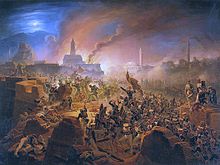Akhaltsikhe
|
Akhaltsikhe ახალციხე |
||
| State : |
|
|
| Region : | Samtskhe Javakheti | |
| Municipality : | Akhaltsikhe | |
| Coordinates : | 41 ° 38 ′ N , 42 ° 59 ′ E | |
| Height : | 1,029 m. ü. M. | |
| Residents : | 17,903 (2014) | |
| Time zone : | Georgian Time (UTC + 4) | |
| Telephone code : | (+995) 261 | |
| Community type: | city | |
|
|
||
Akhaltsikhe ( Georgia ახალციხე , formerly Lomsia , Armenian Ախալցխա Akhalts'kha , in English transcription Akhaltsikhe ) is a city in Georgia .
geography
The city is located at an altitude of 1029 m on the Pozchowiszqali River . It has 17,903 inhabitants (2014). Akhaltsikhe is the capital of the Samtskhe-Javakheti Region and Akhaltsikhe District .
history

The oldest surviving written mention of the city comes from the 12th century. From the 12th to the 13th centuries it was the seat of the Akhaltsichelis , the rulers of Samtskhe . From the 13th to the 17th century, the city was ruled by the aristocratic Jaqeli family. In 1576 it was conquered by the Ottoman Empire and in 1628 the center of the Ottoman province Akhaltsikhe .
During the 8th Russian Turkish War , Russian troops under the command of General Paskevich took Akhaltsikhe on August 27, 1828. An attempt by the Ottomans under Achmed Pasha to recapture the fortress and town in March 1829 was thwarted by General Bebutow . In the Peace of Adrianople (1829), the city and other previously Ottoman areas of Georgia were added to Russia . It initially belonged to the Kutais governorate , later to the Tiflis governorate ( Russian: Tiflisskaja Gubernija ). In 1879 the city had 13,757 inhabitants, in 2009 about 19,200.
Attractions
Akhaltsikhe has a fortress , an aristocratic palace from the 13th and 14th centuries, several Armenian churches, two synagogues (the old synagogue was renovated in 2012), a large Jewish cemetery and numerous, mostly destroyed mosques (once 28). One of them is very well preserved in the fortress. It was converted into an Orthodox church in the 19th century and is connected to a higher education institution. In the hills ten kilometers southeast of the city is the Sapara monastery from the 10th to 14th centuries.
economy
In earlier centuries Akhaltsikhe was a central marketplace for human trafficking . Today the city exports agricultural products such as cattle, hides, tallow , wax, and honey. Wine is grown in the area as well as maize, wheat, barley, cotton, tobacco and flax .
traffic
In 1967 the city received a railway connection when the Chaschuri – Wale railway line , which had ended in Borjomi, was extended to Wale . Today the trains coming from Tbilisi end again in Borjomi, so Akhaltsikhe has to get along without passenger transport by rail.
sons and daughters of the town
- Grégoire-Pierre Agagianian (1895–1971), Patriarch of Cilicia of the Armenian Catholic Church and Cardinal Curia of the Roman Church
- Hovhannes Katchaznouni (1867–1938), first Prime Minister of the Democratic Republic of Armenia (1918–1920)
- Lussine Sakarjan (1937–1992), Soviet-Armenian singer (soprano)
Twin cities
See also
Web links
Individual evidence
- ↑ wp: ru


